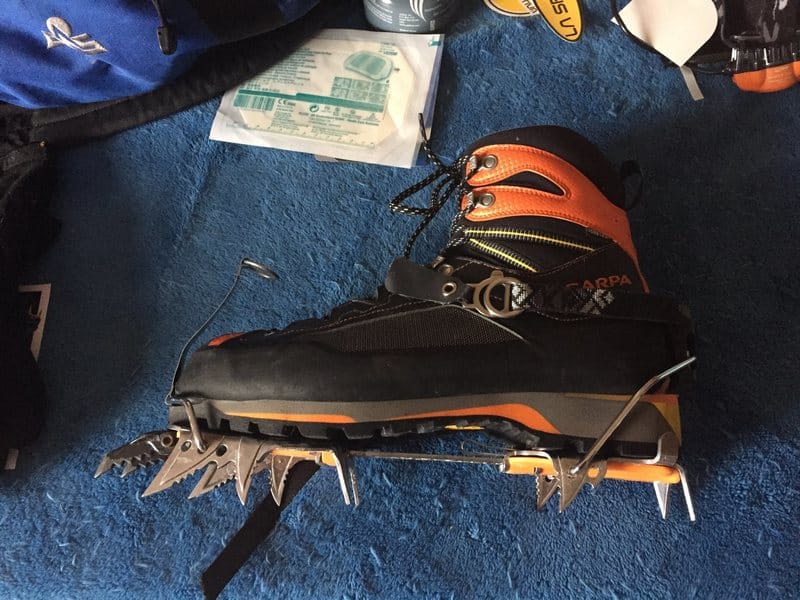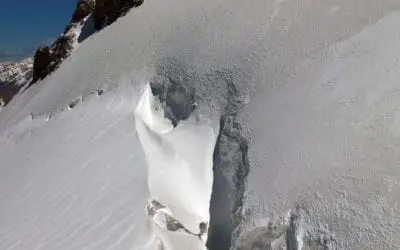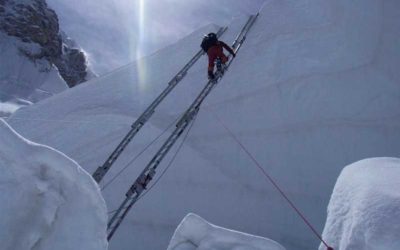
I believe that having sharp crampons is critical when you’re ice climbing. That said, myself and many climbers don’t strictly climb ice only, but use their crampons for Alpine climbing as well.
In short, the front points of crampons should be sharp as knives while the bottoms of the crampons shouldn’t necessarily be as sharp as the front.
In Alpine climbing, you’ll quickly dull your crampons since you’re using them on a mixture of rock and ice, standing on ledges, flakes and rock slabs with them. Not the best use for them, especially if you’re using technical crampons.
If you are reading this I suppose that you are unsure whether or not your crampons are losing their grip. In this article, we will investigate just how sharp your crampons should be and how to go about sharpening them.
Sharp Points Are Critical
The front points of your crampons should be sharp as knives. Sharp point at the front means that you can place your foot into ice and snow without having to kick, conserving your energy and causing less damage to the snow.
The bottoms of your crampons should also be sharp, but not necessarily as sharp as the front points. These are mostly used to gain traction as you’re walking, so they need to be about as sharp as the tip of a ballpoint pen.
Pack a Small File
As mentioned earlier, Alpine climbing is not the best if you want to keep your crampons sharp, since you’re constantly switching between rock, ice and snow. The rock will definitely take the bite out of your crampons, so pack a small file to sharpen your crampons mid-trek, if needed.
Your crampon points are actually blades. If you think of them as such, sharpening them will become a bit easier. As in the kitchen, sharp blades are best.
Usually, you would sharpen your crampon blades at the start of a season instead of mid-trek, but it’s best to be prepared.
Clean Up Before You File
When you’re out in the mountains, you step on all sorts of dirt with your crampons. Before you set about sharpening your crampons, you need to clean them properly. Use some clean water and detergent to do this. If the dirt is a bit stubborn, use a scrubbing brush.
Make sure that you dry your crampons thoroughly before filing or storing them. Filing just works better on dry crampons. Storing them wet puts them at risk of rusting, which you also don’t want.

Sharpening Your Crampons
What You Need
You don’t need much to sharpen your crampons: a file, a small vice and a sturdy pair of gloves.
The specific file you need is called a flat mill bastard hand file, which you can get at most hardware stores. It sounds like a swear word, but bear with me: flat mill refers to the shape of the file (spoiler alert – it’s flat), bastard refers to the roughness of the file (mid-range) and this file is hand-held.
If you don’t have a vice, you can hand hold your file while filing, although this is a bit more challenging than clamping it in a vice. The gloves are to protect your hands, because let’s face it, you’re sticking them into a collection of sharp blades and you have the very real risk of being cut.
10 Tips On How To File Your Crampons
Now that you know what you’re aiming for and which tools you need, let’s get into the nitty gritty:
- The manufacturer made each point with the correct bevel (the angle at which the blade tapers off on the sides). Try to imitate this bevel as you file each point individually.
- Don’t drag the file back and forth across the blade. Instead, push the file in the direction in which its teeth are pointed. This gives you a smoother finish and lengthens the lifespan of your file and crampons.
- As far as possible, keep a straight line between the crampon frame and the tip of the blade.
- File the crampon side points on each side. Luckily, these only have to be about as sharp as the tip of a ball point pen.
- Fronts points must be as sharp as you can possibly get them. Here, it is best to file them from the top, although if it’s a vertical front point, you can file it from each side.
- Avoid using an electrical grinder to sharpen your crampons. You run the risk of overheating the crampon blades, which can cause serious damage – the metal will lose its tempering, making it weak and brittle. If you do decide to use an electrical grinder, use light contact and be sure to wear gloves. Electrical grinding will send tiny metal shavings flying in all directions, so it’s a good idea to wear safety glasses as well.
- When you’re done sharpening your crampons, they need to be cleaned again to remove any residue of the filing process. While cleaning, check that all the burrs are removed from the blades.
- If some of the crampon blades somehow got bent at some point, you can straighten these in the vice.
- As a last step, you need to check your crampons for overall quality. We all know that they take quite a beating when in use, so check the frame and blades for fatigue cracks. These are small cracks running across the frames or blades, induced by overuse. The side walls of your blades will thin with repeated filing – check that these aren’t too thin. Lastly, check all the rivets, plastic cages and straps for wear and tear.
- It’s a good idea to go through all of this at the start of each climbing season to ensure that you’re climbing with proper, safe gear.
Conclusion
Having sharp crampons is crucial if you are doing technical climbs where your safety will depend on you having good grip.
I wouldn’t obsess about sharpness as long as you regularly inspect your crampons and keep an eye on the edges of the front points. The sharpness of the bottoms of the crampons are not as important as the front.
Remember that you should make sure the crampons are a good fit with your boots. A bad fit could be as problematic as having blunt crampons. Happy adventures!
Written by Felix

About me
Hi! I’m Felix. When I’m not spending time out in the mountains, I like to write about my hobbies. That is how Mountain Homies was created. On this site, I try to gather all the juicy information about Mountaineering that I have learned since I started. Happy adventures!
Related Articles
3 Ways to Spot and Reveal a Crevasse (And Avoid It)
So, how do you spot a crevasse and – more importantly – avoid falling into one? In this article, I will have a look at what crevasses are and how to detect them…
5 Ways of Knowing If Your Climbing Shoes Are Too Big
It has almost become a prestige among climbers to be able to boast about how small and tight climbing shoes can be used. There is therefore a lot of talk…
3 Clever Ways of Crossing A Crevasse
When you’re mountaineering in snow country, you will undoubtedly encounter some crevasses. These are scary, since you don’t always spot them…
Stay Up to Date With The Latest News & Updates
Join Our Newsletter
The owner of this site is a participant in the Amazon Services LLC Associates Program, an affiliate advertising program designed to provide a means for sites to earn advertising fees by advertising and linking to amazon.com.



